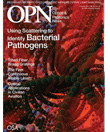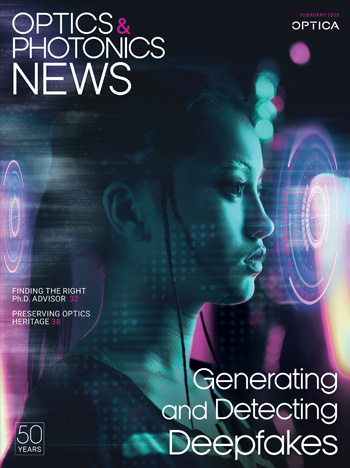
October 2011 Issue
Feature Articles
Recollections of the First Continuous Visible Laser
Alan White worked as a member of the technical staff at Bell Labs during its heyday for industrial research. Here, he recalls his work with Dane Rigden to develop the first continuous visible helium-neon laser in 1962—and how the project evolved from covert weekend tinkering to the talk of the lab.
by Alan D. WhiteUsing Scattering to Identify Bacterial Pathogens
New advances in elastic light scattering technology allow for faster and more accurate identification of bacteria. By using globally networked libraries of unique scattering patterns produced by bacterial colonies, researchers have developed an efficient method of identifying pathogens that has potential applications in food and water safety, health care and biodefense.
by J.P. Robinson, B.P. Rajwa, E. Bae, V. Patsekin, A.M. Roumani, A.K. Bhunia, J.E. Dietz, V.J. Davisson, M.M. Dundar, J. Thomas and E.D. HirlemanTilted Fiber Bragg Gratings as Multi-Sensors
The tilted fiber Bragg grating is a new kind of sensor that possesses all the advantages of well-established Bragg grating technology in addition to being able to excite cladding modes resonantly. This device opens up a multitude of opportunities for single-point sensing in hard-to-reach spaces.
by Jacques AlbertLight in Flight: Optical Applications in Civilian Aviation
Optical technologies such as head-up displays, fiber sensors and quantum dots will help build 21st century airplanes, connect pilots to crucial information and ensure the structural health of aircraft.
by Patricia DaukantasDepartments and Columns
Britain's Acoustic Mirrors
Just as lenses reflect and concentrate light, dish-like structures called acoustic mirrors can amplify sound. These odd-looking devices have played a key role in the military history of Great Britain—and are now getting a second life as works of art.
Approximated Scatter Models for Stray Light Analysis
In the absence of measured data, stray light estimates can be daunting for engineers who do not regularly make scatter calculations. Here’s how to make reasonable approximations.
Making the Leap from Grad Student to Professor
Doing a teaching stint right out of graduate school is an often overlooked alternative to carrying out a postdoc that can allow you to explore new topics, interact with students and keep your options open.
OPN Talks with Ferenc Krausz
Our conversations with Ferenc Krausz, attosecond aficionado and FiO plenary speaker.
Controlling Animal Behavior with Light
Scientists used optogenetics—a combination of genetic engineering and laser technology—to study the pathways between two parts of the brain involved in feeling reward.
Missing Links in OSA’s Archives
As OSA approaches it centennial in 2016, its staff and volunteers are working to compile a comprehensive history of the organization. While we are gathering much information, there are still a few elusive missing photos and biographies.
OPN Talks with Jorge Rocca
Our conversations with Jorge Rocca, compact X-ray laser luminary.
Exploring Mechanochromatic Dyes
Researchers can tune the optical properties of their boron-based reversible mechanochromic dyes with simple changes to the dye's chemical makeup.
Scientists Image Rods in the Living Eye
New research demonstrates a way to image tiny but important light receptors in the living eye.
Nanoscale Waveguide Steers Photonic Possibilities
Recent experiments demonstrate a new technique for confining light in nanoscale waveguides.

![Illustration of a synapse in the brain. [Getty Images]](https://opnmedia.blob.core.windows.net/$web/opn/media/images/articles/2025/0425/departments/202504-cover-web.jpg?ext=.jpg)
![Fiber draped around a hand, demonstrating its flexibility. [Photo by Z. Wang and L. Wei]](https://opnmedia.blob.core.windows.net/$web/opn/media/images/articles/2025/0325/departments/202503-cover-web.jpg?ext=.jpg)
